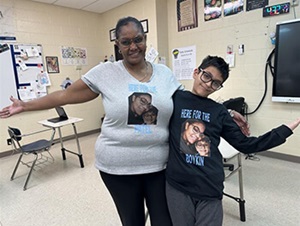
Liam Patel, 12, is passionate about math, science, art and music. He loves playing video games, riding his bike and spending time with his friends. But when he was 9 years old, he developed a rare condition that disrupted communication between his gut and his brain.
“I woke up one night and my stomach was hurting,” says Liam. “I thought I was sick or something, but it never really stopped. It was overwhelming pain and I couldn’t do much at all.”
His symptoms — stomach pain, vomiting, bowel changes and fatigue — became so severe that he was often unable to get out of bed.
“He missed more than 100 days of school in fourth, fifth and sixth grade,” says his mom, Erin Patel.
Finding the right care
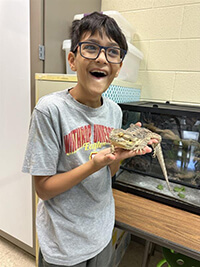 After multiple failed therapies and second opinions, Liam was referred to Atrium Health Levine Children’s Hospital, named a ‘Best Children's Hospital’ for pediatric gastroenterology & GI surgery by U.S. News & World Report.
After multiple failed therapies and second opinions, Liam was referred to Atrium Health Levine Children’s Hospital, named a ‘Best Children's Hospital’ for pediatric gastroenterology & GI surgery by U.S. News & World Report.
Dr. Daniel Kelly, a pediatric gastroenterologist, and the team at Atrium Health Levine Children’s Disorders of Gut-Brain Interaction (DGBI) clinic developed a comprehensive plan to help manage Liam’s symptoms and restore his quality of life.
Liam was diagnosed with collagenous gastritis, irritable bowel syndrome and a disorder of gut-brain interaction that had severely disrupted his daily life.
“His collagenous gastritis caused anemia and more acid-related symptoms, which could very possibly have triggered his DGBI,” says Kelly.
When Liam continued to have significant symptoms, his care team had to pivot and address both conditions at the same time.
“It’s a great example of how treatment needs to be personalized — we need to consider the patient as a whole, which requires active listening and thinking critically when things change,” says Kelly.
“We went from feeling like we were at our lowest point to feeling like we had a path forward,” says Erin. “Dr. Kelly always makes sure we’re taken care of.”
Liam’s plan included IB-Stim therapy, cognitive behavioral therapy, dietary changes and medications.
IB-Stim: An innovative approach
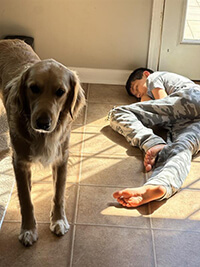
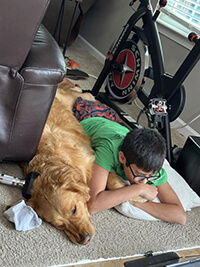 “IB-Stim is a nerve field stimulator that targets what we call ‘cranial’ nerves,” says Kelly. “By stimulating these nerves, we can target areas of the brain that process pain and nausea.”
“IB-Stim is a nerve field stimulator that targets what we call ‘cranial’ nerves,” says Kelly. “By stimulating these nerves, we can target areas of the brain that process pain and nausea.”
With DGBIs, the signals from the intestines are normal, but the brain perceives them as a threat, creating pain and nausea. IB-Stim helps retrain the brain to interpret these signals as normal, reducing symptoms over time.
“We’ve offered IB-Stim treatments here at Atrium Health since it received FDA approval for IBS in 2019,” says Kelly. “Liam is one of hundreds of patients we’ve treated here with this device who have shown the transformative benefits of the treatment.”
While patients with DGBIs may not be completely symptom-free, many only need one course of IB-Stim to significantly improve their function and quality of life.
The role of mental health
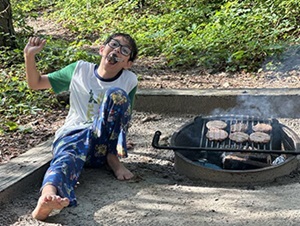 Cognitive behavioral therapy is also essential for Liam and others with DGBIs.
Cognitive behavioral therapy is also essential for Liam and others with DGBIs.
“As a patient, you can't change how often symptoms occur or when they come on, but you can change how you respond to them,” says Kelly. “Doing so in the right way with the guidance of a psychologist can make a huge difference and that is where therapy comes in.”
Learning cognitive behavioral skills empowers patients like Liam to cope with their symptoms and gradually re-engage with meaningful aspects of life like attending school, enjoying hobbies and spending time with friends, which are often disrupted by chronic digestive issues.
Liam’s transformation
 On this treatment plan, Liam’s symptoms drastically improved.
On this treatment plan, Liam’s symptoms drastically improved.
“After just a couple of weeks, his vomiting, pain, bowel movements and sleep started to significantly improve,” says Kelly. “He was able to return to school and get caught up with missed work. For the first time in a long time, he was able to go out to eat at a restaurant, have sleepovers and go on vacation.”
Kelly says Liam’s transformation has been incredible to watch.
“I was able to see this hopeless, unwell-appearing kid completely transform into a happy, mostly symptom-free kid enjoying life for the first time in a while,” he says. “He’s an absolute goofball and can really light up a room.”
Having access to this care close to home has also made a big difference.
“Having the specialty clinic right in our backyard has been unbelievable,” says Erin. “We’re not having to travel hours or across states like other families. He gets the care he needs here in Charlotte.”
Hope for the future
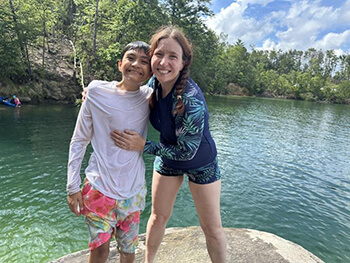 Liam’s experience as a patient has shaped his future aspirations.
Liam’s experience as a patient has shaped his future aspirations.
“He wants to grow up to be a doctor just like Dr. Kelly or a veterinarian,” says Erin. “He’s in seventh grade, all honors classes and is doing well academically. He’s a hard worker and determined not to let this experience define him.”
Liam is grateful for the support of his parents, his dog, Luna, and his homebound teacher, Ms. Boykin, who helped him keep up academically.
“A few days ago, I had the longest streak of being in school consecutively, which was nice,” says Liam. “It shows the progress I’ve made and that everything is helping and I’m growing out of it.”
“That’s why we chose to do IB-Stim,” says Erin. “With a kid who fights that hard, you want to fight that hard for him.”
“I’m too stubborn to quit,” adds Liam.
For the first time in years, Liam is back to riding the bus, playing outside with friends and enjoying a typical childhood.
“He has bad days, but it’s only a few days instead of a month,” says Erin. “We’re now seeing a kid who can jump off rocks and go camping in the summer.”
Looking ahead, Liam is excited about attending a STEM camp next summer and one day working in a veterinary clinic.
“Liam has an idea of what his life is going to look like and we’re here to watch him do that,” says Erin.
“I’m excited for the future,” says Liam.



